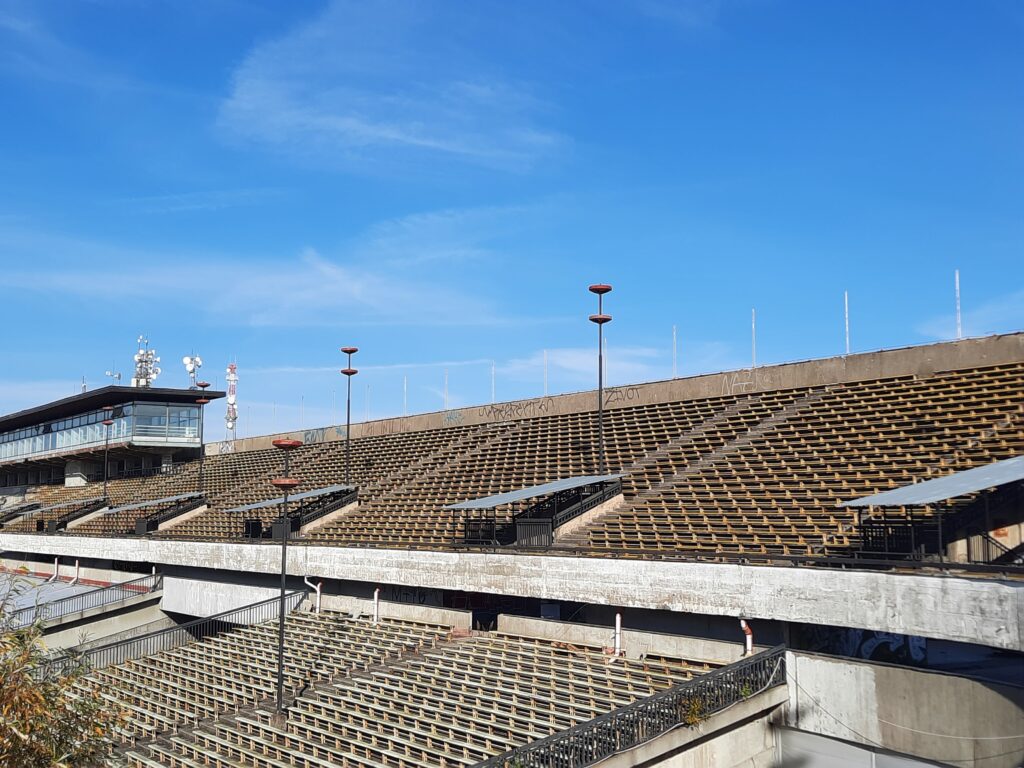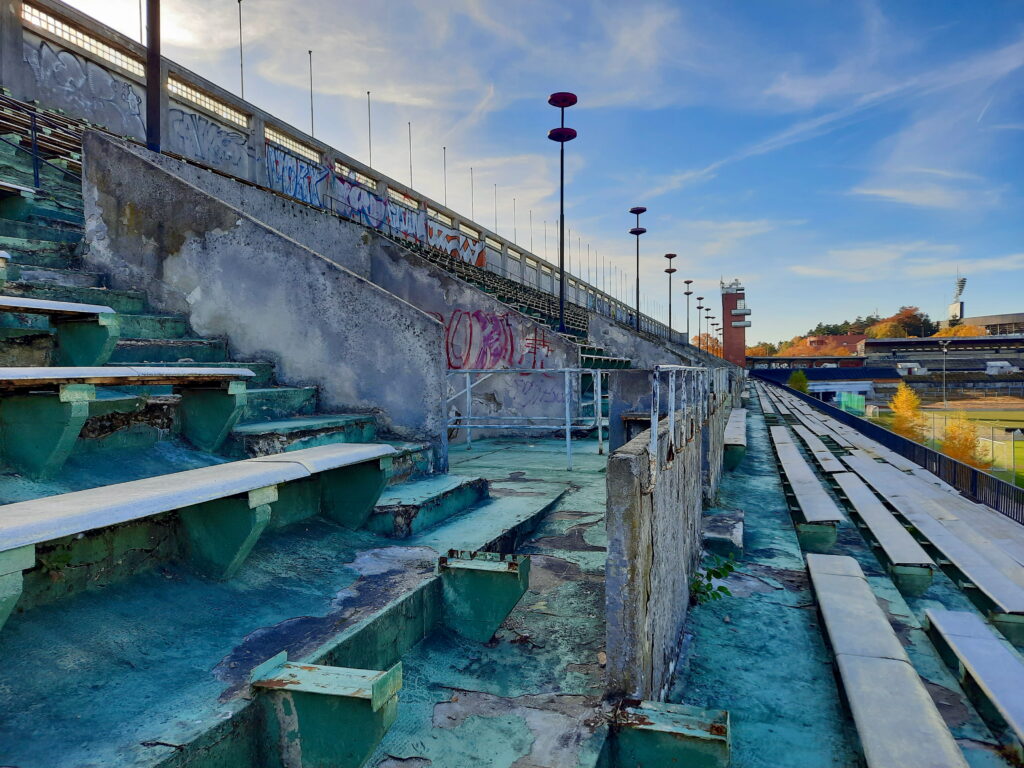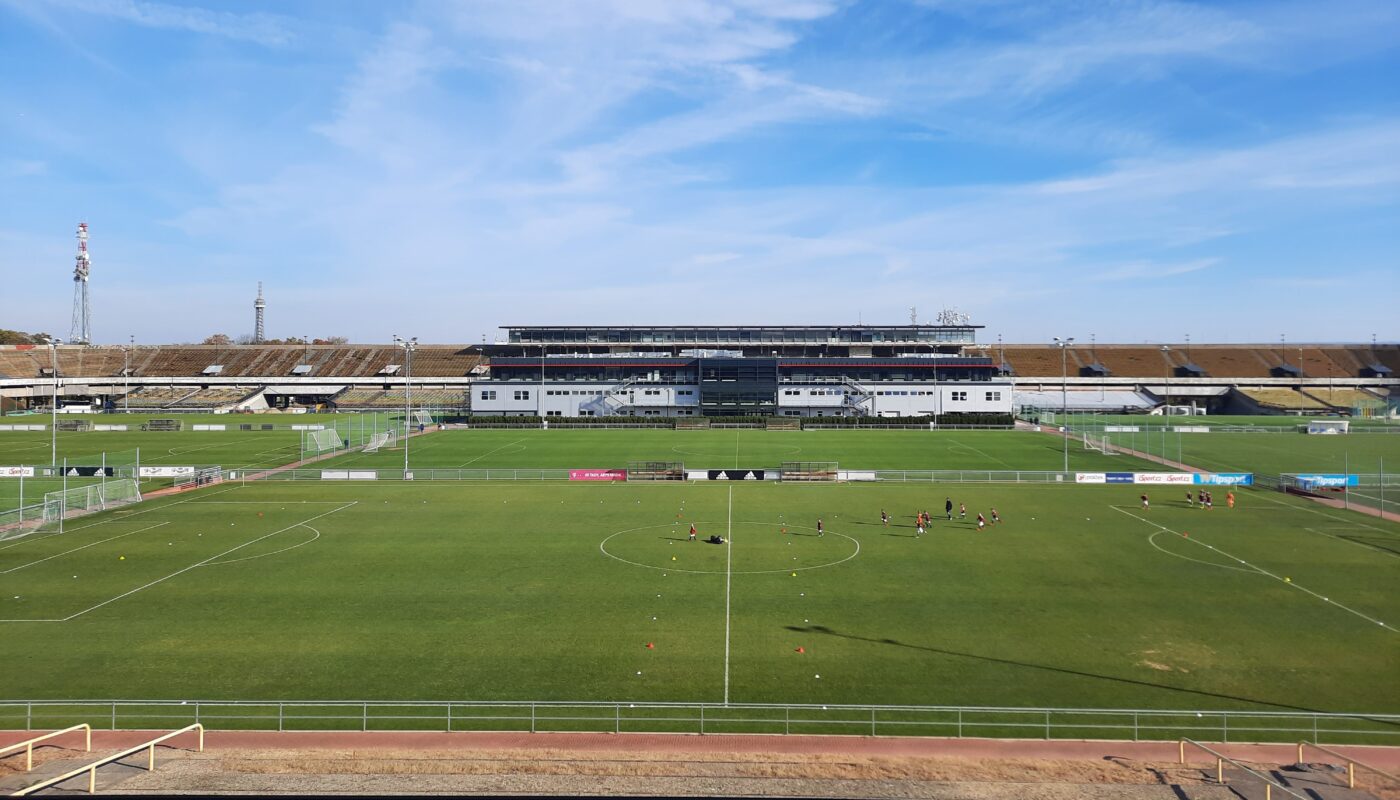Reading Time: 4 Minutes 9 Seconds
The Great Strahov Stadium (Velký Strahovský Stadion) was once the largest stadium in the world, boasting an area of 63,000 m3 and a capacity of 250,000.
The Strahov Stadium complex, which has remained unused for many years, is situated on top of the Strahov hill, from which you have a superb and free view of Prague.
History of the Strahov Stadium
To accommodate the Sokol meetings, in 1926 the construction of the stadium began, based on the project of architect Ludvík Čížek.
Sokol is a gymnastics and physical education organization established during the Austro-Hungarian Empire.
The design of the stadium included a clay base, a sand training field, and partially covered wooden stands, all supported by steel and reinforced concrete structures.
In the early 1930s, the large stadium underwent renovations according to the plans of architect Alois Dryák, with further modifications continuing in the following years.
The Sokol rallies were scheduled to happen every 6 years and the following one took place in 1932. President T. G. Masaryk attended it, arriving on horseback.
In 1938, the western stand and two six-storey towers were completed. That same year marked the last Sokol rally before the Nazi invasion of Czechoslovakia.
During this event, Masaryk publicly bid farewell to the citizens for the final time, driving around the stadium multiple times, while waving a red and white scarf (the national colors) from a convertible.
It was in his honour that the stadium was renamed after him (Stadion Masarykův).
The saddest chapter in the stadium’s history unfolded during the war. It hosted German army parades, including one for Adolf Hitler’s 50th birthday in 1939.
After the end of World War II, Germans gathered at the stadium while awaiting transportation out of Bohemia and Czechoslovakia.
The stadium served as the site for commemorating the 30th anniversary of the Battle of Zborov, an event attended by President Edvard Beneš , featuring legionary cavalry and military vehicles.
The Sokol rally in 1948 became a significant protest against the beginning of the communist regime. Soon thereafter, the Sokol organization, and mass propaganda gymnastic events known as Spartakiády took their place.
The Spartakiády
The first Spartakiáda was held at the Strahov Stadium on the 23th June 1955, to commemorate the 10th anniversary of Czechoslovakia’s liberation by the Red Army.
While the Sokol rallies occurred every 6 years, the Spartakiády took place every 5 years, attracting gymnasts and spectators from across Czechoslovakia to Prague for a week of festivities and celebrations.
It is estimated that in 1960, during the second performance of this monstrous propaganda of the communist regime, 750,000 gymnasts and over 2,000,000 spectators participated.
The Spartakiáda in 1970 did not take place due to the Soviet invasion in 1968.
In addition to the stadium itself, it is worth mentioning that motorcycle and car races were held on the roads surrounding the venue, allowing spectators to watch from the outer galleries.
The 1960s also saw the addition of an indoor athletics track and running tracks within the galleries.
In 1961, the eastern gallery of the stadium was rebuilt in the Brussels architectural style, and 11 pavilions for university dormitories were constructed.
The stadium was fully completed in 1980, becoming the central sports facility for the Czechoslovak Association of Physical Education and Sports (ČSTV).
The last Spartakiáda was held in 1985.
Even though the resolution is pretty bad, below you can find a video capturing those memorable days of 1985.
The Strahov Stadium after 1989
In general, it must be said that after the fall of Communism, the stadium became largely impractical due to its disproportionate size. It remained unused and neglected for many years, ultimately suffering from deterioration.
Weeds and trees began to grow both on the pitch and in the stands, leading to significant disrepair of much of the structure.
During the 1990s and the early 2000s, the stadium hosted various exhibition events and concerts of famous bands.
Notably, on 18th August 1990, one of the largest rock concerts of the Rolling Stones took place, which drew an audience of approximately 100,000 people, including the then President of the Republic, Václav Havel.
Other bands that have performed at Strahov include Guns N’ Roses in 1992, Bon Jovi in 1993, Aerosmith and Pink Floyd in 1994, U2 in 1997, AC/DC in 2001, and Rammstein and Ozzy Osbourne in 2002.
In the early 2000s, there were proposals to demolish the stadium. However, it was ultimately decided to preserve the structure.
On 6th March 2003, the concrete galleries were designated as cultural monument of the Czech Republic.
The Strahov Stadium is currently utilized by the football team “Sparta Praha”, who have a rental agreement for its use until 2030.
The future of the stadium
According to the plans of the city of Prague, the Strahov Stadium is to become a place of sports, culture and art. In short, a creative center and a meeting place with our own history.
In 2021, it was announced that a tender would be opened for the future use and appearance of the stadium.
Among the proposals is the creation of a permanent exhibition of the Museum of the Memory of the Nation of the 20th Century.
Another plan is to work with the Technical university of Prague (ČVUT) to create an innovation centre, where to test the latest technologies.
Some parts of the stadium can be visited during some open days, or when the football team trains.
In the photos below you see the condition of the stands.



